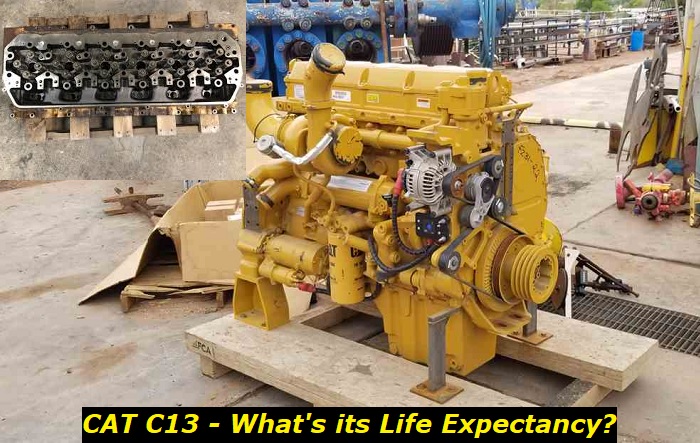CAT C13 Life Expectancy and Ways to Prolong Its Life
The CAT C13 is an industrial-level diesel engine Caterpillar (CAT) produces. Vehicles like buses, fire trucks, and tractor-trailers use it. You will also find the C13 in excavators, combine harvesters, and tanks. The Caterpillar C13 engine is found in machines from Caterpillar, Freightliner, Sisu, Harimau, and Gleaner. For such expensive industrial machines, it is vital that they have engines with solid life expectancy.

Caterpillar claims that with their recommended maintenance, the C13 engine has a B50 life expectancy of one million miles. This article interrogates this claim. In addition, we look at ways to prolong the life of the C13 and consider conditions that reduce it. Before we dive into that, we will do a quick overview of the CAT C13 engine.
CAT C13 Specifications Overview
The CAT C13 engine is an inline-6 diesel engine, meaning it is a piston engine that has six cylinders that are lined straight across the crankshaft. The C13 is a powerful engine used in a variety of machines for construction, haulage, mining, agriculture, transport, etc. Some of the critical specifications of the CAT C13 include:
|
Engine Configuration |
Inline-6, 4-stroke cycle diesel |
|
Displacement |
12.5l |
|
Bore |
130 millimeters |
|
Stroke |
157 millimeters |
|
Compression Ratio |
17.3:1 or 15.8.1 |
|
Combustion System |
Direct Injection |
|
Aspiration |
Turbocharged Aftercooled (TA) |
|
Maximum Power |
536 Horsepower (hp) / 400 Kilowatts (kW) |
|
Minimum Power |
385 hp / 287 kW |
|
Maximum Torque |
2353 Newton Meters @ 1400 Revolutions Per Minute (rpm) |
|
Rated Speed |
1800 – 2100 rpm |
|
Length |
1295 millimeters |
|
Width |
1054 millimeters |
|
Height |
1186 millimeters |
|
Weight (Basic Operating Engine) |
1138 Kilograms |
|
Emissions |
US EPA Tier 3, China Nonroad Stage III, United Nations ECE R96 Stage IIIA, Brazil MAR-1 |
There are different models of the C13. The specifications above will vary with the particular model of the 13 in your machine. For example, the early models of CAT C13 are tier-3 compliant, which is not the most recent US environmental protection agencies (EPA) emission standard for engines. However, CAT C13 ACERT engines with the “LEE” engine prefix are tier-4 compliant. The power ratings of the C13 engines range from 385 hp to 536 hp.
CAT C13 Life expectancy
The official claim by CAT regarding the C13 is that up to fifty percent of CAT C13 engines will reach one million miles in so far as they are maintained using their recommendations.
There is no guarantee that your engine will get to a million miles even with proper maintenance since the claim is a B50 life expectancy (one in two). Owner reviews indicate that this claim is not often met. Instead, many user reviews have indicated a life expectancy between 500 000 and just under a million miles before they were overhauled. Those numbers are still quite impressive.
It should be noted that besides maintenance, the type and intensity of work, environment, and terrain you use the C13 on will have an effect on its long-term durability. The C13 will last longer without a rebuild if used for less demanding applications.
CAT offers a 24-month or 2000-hour standard warranty, whichever occurs first. The first 12 months are at unlimited hours.
How To Prolong the Life of The CAT C13 Engine
CAT says that half the C13 engines will reach a million miles if maintained with their recommendations. As such, in making suggestions for prolonging a C13 engine’s life span, we have taken some cues from the C13’s operator manual.
1) Regular Maintenance
It is crucial that as the owner or operator of a CAT C13 powered machine, you carry out frequent maintenance procedures in line with the manual’s recommended maintenance schedule. Maintenance procedures will include:
· All adjustments
· Replacing lubricants, fluids, and filters
· Replacement of worn and aging components
Without maintaining the C13 engine with correct intervals, you risk reduced performance and faster wear of the engine’s components. Use the mileage, service hours, calendar time, or fuel consumption to determine the maintenance interval. Use the first one that occurs.
The frequency will depend on the conditions you operate the engine. Severe operating conditions may need more frequent maintenance procedures.
Note that you must do all the maintenance from previous intervals before the consequent intervals. Also, ensure you adhere to all safety information, instructions, and warnings before performing maintenance procedures.
Particular maintenance schedules are only needed when required. For example, battery replacement and recycles, priming fuel systems, or draining fuel tank water and sediments should be done when needed. Some schedules need to be conducted based on their service hours. For example, replace the diesel exhaust manifold filter every 10,000 service hours and change the engine oil and filter every 500 service hours. Some maintenance schedules should be done after specific amounts of fuel have been consumed. Overhaul considerations should come after 130,000 miles have been met.
Go through your user manual to see the details on the frequency of maintenance procedures for the C13 engine and its different components. Improper or inadequate maintenance may cause severe problems.
2) Frequently Inspect the Engine
Besides performing regular maintenance, it is crucial to inspect the engine frequently for wear or damage. Routine inspection is a way to detect problems before they escalate to something that shortens the engine’s lifespan. Also, regular inspection of the C13 engine will help you identify costly or expensive engine problems before they become so.
Regular inspection will also help you keep your engine performing efficiently and, in some cases, comply with government regulations.
Some things you should inspect frequently include:
· Fluid levels
· Air filter
· Belt and hoses
· Fuel system
· Spark plugs
· Battery
· Compression
· Ignition
· Exhaust system
Also, use a diagnostic tool to scan your engine now and then to detect hidden problems with the engine and the vehicle. Early detection through inspection will help the health of your C13 engine in the long term. Repair detected issues as soon as possible.
3) Use Recommended Engine Oil
Engine oil is important in any engine. It helps lubricate moving engine parts, reducing friction and wear. Engine oil also dampens shock, protects against corrosion, cleans and cools the engine, and more. Nevertheless, all engines are not the same, and neither is the engine oil they need.
Caterpillar has recommendations for the type of engine oil you should use in the CAT C13 engine due to the significant differences in their quality and performance. The engine oil recommendations by CAT are:
· CAT DEO ULS (Diesel engine oil ultra-low sulfur) - SAE 5W-40
· CAT DEO ULS (Diesel engine oil ultra-low sulfur) - SAE 10W-30
· CAT DEO ULS (Diesel engine oil ultra-low sulfur) - SAE 15W-40
Besides the CAT DEO-ULS, you can use engine oils that are compliant with the CAT ECF-3 or API CJ-4 specifications. Their chemical limits will help the device lifetime performance and service interval of aftertreatment devices. If you cannot find oils that meet the CAT ECF-3 or API CJ-4 specifications, you can use ACEA E9 oils.
Using the wrong type of oils will have adverse effects, especially for aftertreatment devices like the Diesel Particulate Filter (DPF) and Diesel Oxidation Catalysts (DOC). See the manual or talk to your oil supplier for more information.
4) Use Recommended Fuel
For optimal performance and life of your CAT C13, it is essential that you use fuels that are compatible. The diesel fuel you put into the fuel tank must comply with “CAT specifications for distillate fuel” and the most recent version of “EN 590” or “ASTM D975”. Using fuels with higher levels of sulfur than required can have negative consequences for the life of the engine.
Some other issues misfuelling can cause, according to CAT, include:
· Increment in the frequency of service intervals for aftertreatment devices like the DPF and DOC.
· Reduction in the efficiency and durability of the CAT C13
· Increase the corrosion, wear, and deposits
· Reduces the fuel economy
5) Operate The Engine at Normal Conditions
Using the C13 engine outside of what it is capable of doing or its normal conditions will reduce its lifespan. In addition, when used in severe service applications, you will need to carry out more frequent maintenance.
So, to guarantee the reliability and service life expectancy of the CAT C13 in your vehicle read the manufacturer’s instructions or discuss with your dealer to know the limits of what it can do. If your vehicle with a C13 engine does not support specific applications, and you use it for such, do not expect to get close to the million-mile figure that CAT suggests.
Conditions That Can Reduce the Life Expectancy of The CAT C13
As much as you should know what to do to increase the life expectancy of a CAT C13 engine, you should also know the things that can reduce it. They include
· Severe service application
· Operation outside of the recommended application
· Improper maintenance procedures
· Regular operation in dirty air
· Regular operation at altitudes above 1525 meters
· Regular use in ambient temperatures higher than 32 degrees Celsius or below 0 degrees Celsius.
· Regular operation when inlet air has corrosive or combustible content
· Plugged fuel filter
· Regular hot shutdowns
· Regular dry starts after 72 hours of shutdown
· Usage above engine-rated speed or below peak torque
These are some of the things that can reduce the life expectancy of your CAT C13 engine; there are others. Consult your user manual to discover them. Once you know the things not to do, avoid them to increase the lifespan of your C13 engine.
Conclusion
This article has looked at the life expectancy of the CAT C13 engine and the ways to prolong it. The life expectancy of the CAT C13 is somewhere between 500,000 and a million miles. However, how it is used can affect this number. You can elongate or prolong the life of the CAT C13 engine with regular inspection and maintenance, use of the recommended oil and fuel, and operating the engine within normal conditions.
We also outlined things that can reduce the life of the CAT C13. If you are keen on using your engine for a long time, follow our recommendations and the CAT C13 manual. Make sure all the CAT C13 maintenance procedures are done using Caterpillar’s recommendations to guarantee a high life expectancy.

Add comment